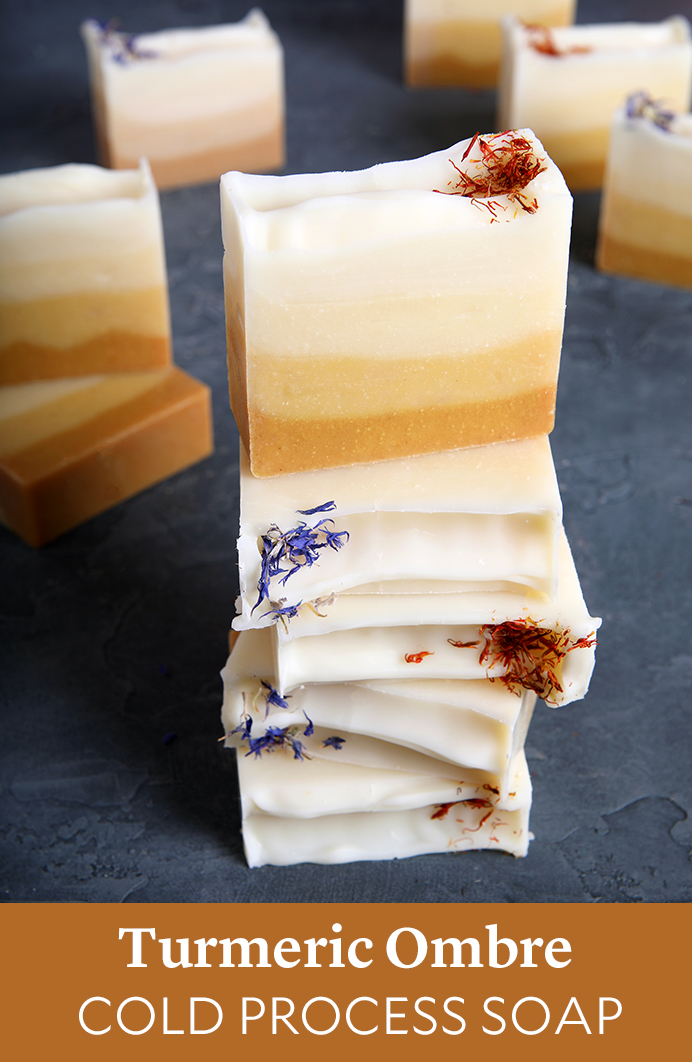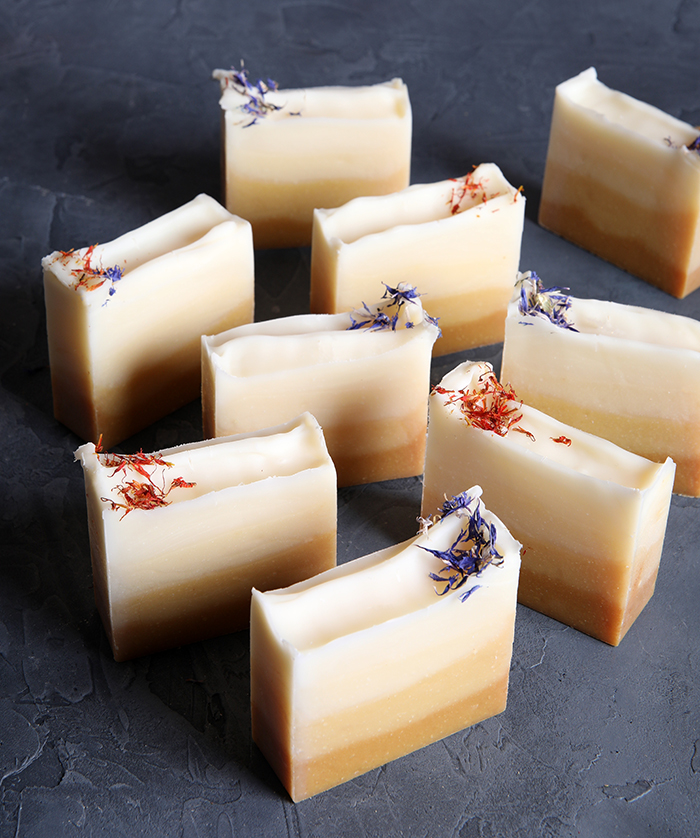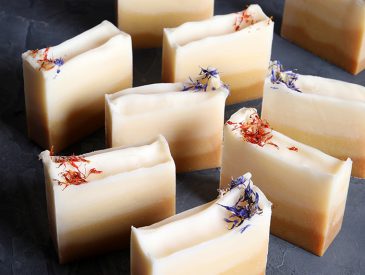This Turmeric Ombre Soap is all about simplicity. It has skin-loving ingredients like cocoa butter, turmeric shea butter, and sunflower oil. The ombre design is made by layering various shades of turmeric powder. For a pop of color, the soap is topped ...

Yesterday on Soap Queen... |
|
|

This Turmeric Ombre Soap is all about simplicity. It has skin-loving ingredients like cocoa butter, turmeric shea butter, and sunflower oil. The ombre design is made by layering various shades of turmeric powder. For a pop of color, the soap is topped with cornflower petals on one half and safflower petals on the other. The bars are unscented, which makes this recipe perfect for those with sensitive skin. Feel free to add a fragrance or essential oil if you’d like – find out how much to use with our Fragrance Calculator. To help the turmeric pop, we recommend forcing gel phase. Soaping a little bit warmer (120-130°F) and placing the soap on a heating pad should do the trick. 
Turmeric Ombre Cold Process Soap Author: Bramble Berry Recipe type: Cold Process Soap - 5 Pound Wood Mold with Sliding Bottom
- Silicone Liner for 5 Pound Wood Mold
- 1.6 oz. Castor Oil (3%)
- 2.2 oz. Cocoa Butter (4%)
- 16.2 oz. Coconut Oil (30%)
- 7 oz. Olive Oil (13%)
- 13.5 oz. Palm Oil (25%)
- 10.8 oz. Sunflower Oil (20%)
- 2.7 oz. Turmeric Shea Butter (5%)
- 7.7 oz. Sodium Hydroxide Lye
- 16 oz. Distilled Water (10% water discount)
- Turmeric Powder
- Cornflower Petals
- Safflower Petals
- Slowly and carefully add 7.7 ounces of lye to 16 ounces of distilled water. Gently stir until the lye has fully dissolved. Set it aside to cool. If you'd like a harder bar of soap that releases faster from the mold, you can add sodium lactate to the cooled lye water. Use 1 teaspoon of sodium lactate per pound of oils in the recipe. For this recipe, you'd add 3.5 teaspoons sodium lactate.
- Melt and combine 1.6 ounces of castor oil, 2.2 ounces of cocoa butter, 16.2 ounces of coconut oil, 7 ounces of olive oil, 13.5 ounces of palm oil (remember to fully melt the entire container of palm oil before portioning), 10.8 ounces of sunflower oil, and 2.7 ounces of turmeric shea butter into a large mixing bowl. Once the lye water and the oils have cooled to 130 degrees F or below (and are ideally within 10 degrees of each other), add the lye water to the oils and stick blend the mixture to a thin trace.
- Split the batch of soap into four equal containers - each will hold about 600 mL. Add the following amounts of dispersed turmeric powder and whisk the colorants in. Adjust with more color if necessary.
Container A: 1 tablespoon + 1 teaspoon dispersed turmeric
Container B: 1.5 teaspoons dispersed turmeric
Container C: ¼ teaspoon dispersed turmeric
Container D: none - Stick blend the darkest color for a few seconds to thicken to a medium trace. The soap should be the texture of pudding. It needs to be thick enough to support the layers above it. Pour all of this soap into the mold and tap on the counter to get rid of bubbles. Smooth with a spoon if necessary.
- Stick blend container B for a few seconds to thicken to medium trace - it needs to be thick enough to support the layers above it. Pour or spoon all of this soap into the mold. Be careful to not break through the layer below. Smooth with a spoon and tap on the counter to get rid of bubbles. Whisk the other containers of soap to ensure they are not getting too thick.
- If necessary, stick blend container C for a few seconds to thicken to medium trace. Pour or spoon all of this soap into the mold. Be careful to not break through the layer below. Smooth with a spoon and tap on the counter to get rid of bubbles.
- If necessary, stick blend container D for a few seconds to thicken to medium trace. Pour or spoon all of the soap into the mold. Be careful to not break through the layer below. Smooth with a spoon and tap on the counter to get rid of bubbles.
- Use a small spoon to create a side wave texture on the top of the soap. There is no right or wrong way to do this, so have fun with it.
- Once you're happy with the top, sprinkle cornflower petals or safflower petals onto the soap. Or, sprinkle both on either side of the mold. Lightly press the petals into the soap with gloved hands to help them stick once cut.
- This soap benefits from gel phase because it helps natural color of the turmeric powder pop. To increase the temperature of the soap, place the mold on a heating pad set to medium for 1-2 hours.
NOTE: The amount of time on the heating pad will vary depending on your climate and how hot the lye and oils were when mixed. Keep your eyes on the soap for the first hour to help gauge the temperature. Gel phase will first begin in the center of the soap and spread out to the sides. If gel phase is not occurring in the first 15 minutes or so, increase the temperature of the heating pad and insulate with a blanket. Just be careful that it doesn't get too hot and crack. - Allow the soap to stay in the mold for 1-3 days (depending if you used sodium lactate or not). Carefully remove from the silicone liner and cut the soap into bars. Cutting these bars from the side can help prevent drag marks from the petals on top. Allow them to cure for 4-6 weeks and enjoy!
3.3.3077 The post Turmeric Ombre Cold Process Soap appeared first on Soap Queen. |
|
Email subscriptions powered by FeedBlitz, LLC •





Keine Kommentare:
Kommentar veröffentlichen